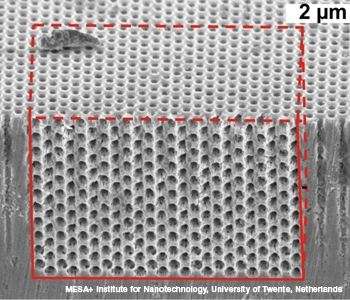Scatterings
Suppressing Spontaneous Emission Inside a Photonic Crystal
Scientists at the University of Twente (Netherlands) have demonstrated a prediction made nearly a quarter-century ago: that spontaneous emission of light can be inhibited within a 3-D photonic bandgap.
 Scanning electron microscopy image of a 3-D inverse-woodpile photonic crystal made from silicon. The red dashed line delimits the 3-D crystal, which is surrounded by a 2-D crystal.
Scanning electron microscopy image of a 3-D inverse-woodpile photonic crystal made from silicon. The red dashed line delimits the 3-D crystal, which is surrounded by a 2-D crystal.
Scientists at the University of Twente (Netherlands) have demonstrated a prediction made nearly a quarter-century ago: that spontaneous emission of light can be inhibited within a 3-D photonic bandgap (Phys. Rev. Lett. 107, 193903). By learning how to control such emission and suppression, researchers could someday build better solid-state lasers or reduce the noise in quantum computers.
…Log in or become a member to view the full text of this article.
This article may be available for purchase via the search at Optica Publishing Group.
Optica Members get the full text of Optics & Photonics News, plus a variety of other member benefits.
